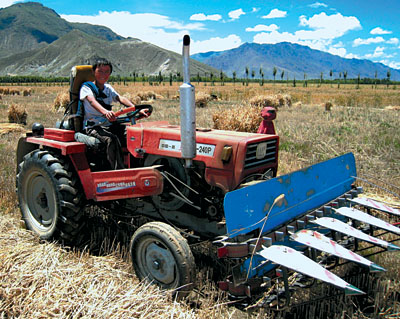|
As the leading industries in Tibet, agriculture and animal husbandry have weak foundatio‘" due to history and nature. Especially restricted by poor traffic conditions, most of the local characteristic agricultural and livestock products seldom enter the national market. The opening of the Qinghai-Tibet Railway greatly reduces the distance between Tibet and the hinterland, providing unprecedented opportunity for promoting development of Tibet's characteristic agriculture and speeding up the access of agricultural products to the market. In 2007, Tibet Autonomous Region coordinated the economic development in urban and rural areas and made great efforts to accelerate the agricultural industrialization. A total of 195 million Yuan was spent in improving the agricultural infrastructure. New situation was found in rural economic development. Statistics showed that the total output value of agriculture, forestry, animal husbandry and fishery reached 7.5 billion Yuan, up 4 percent over 2006.
Agriculture
 Tibet is going from traditional to modern farming.
Tibet is going from traditional to modern farming.
In the transformation from traditional to efficient, modern agriculture, Tibet is depending on new science and technology. This is increasing the unit production of grains and oil and the utilization rate of agricultural resources and leading the agricultural economy into a favorable situation. In 2007, the region continued implementing the plan on increasing the unit production of grains and tried to overcome the influence of drought. Farmland sown to cereals reached 171,770 hectares, some 110 hectares more than the previous year. Of this, farmland sown with Qingke barley reached 117,990 hectares, an increase of 1,710 hectares; that with wheat 40,290 hectares, a fall of 1,200 hectares; that with rape 23,050 hectares, a decrease of 1,000 hectares; that with vegetables 19,660 hectares, an increase of 670 hectares. Grain production in 2007 reached 938,600 tons, a fall of 1.6 percent; production of rapeseed was 52,300 tons, a fall of 4.0 percent; production of vegetables was 450,600 tons, an increase of 0.3 percent.
At the same time, Tibet is attaching great importance to developing the circulation of goods in rural areas. Agricultural products wholesale markets have been established in four places. The relevant program and preliminary work on the construction of farmers' market and frontier trade market at the basic level were carried out in an all-round way.
In 2007, the government of Tibet, based on increasing the income of farmers and herders and improving their living conditions, constantly increased financial investment in rural areas. A total of 4.02 billion Yuan was invested in agriculture, an increase of 61.4 percent over the previous year. This included a special fund of 145 million Yuan to develop characteristic agricultural and animal husbandry projects; a fund of 48.5 million Yuan to conduct producing technology and quality training for farmers and herders; a fund of 170 million Yuan for comprehensive development in agriculture and animal husbandry; a sum of 62 million Yuan for basic farmland irrigation construction; a fund of 140 million Yuan for rural comprehensive reform; and a sum of 65.33 million Yuan for the prevention and cure of the animal epidemic diseases and plant diseases.
In 2006, Tibet allocated a special fund of 240 million Yuan to develop characteristic agricultural and animal husbandry projects. This benefited 364.000 farmers and herders, who enjoyed a per capita increase in income of 660 Yuan. Meanwhile, Tibet also underscored the training for new-type farmers and herders, allocating 40 million Yuan; 257,000 persons/times of instruction.
Most of the major grain production zones are distributed in arid and semi-arid zones, featuring typical irrigation-dependant agriculture. Hence, the key point of improving the production condition of agriculture and animal husbandry is to accelerate the construction of the irrigation area and improve the level. In 2007, Tibet carried out three projects covering the Manla, Moda and Yarlung irrigation sectors in the drainage areas of the Nam Qu River, Lhasa River and Yarlung River, adding and improving 5,543 hectares of irrigated farmland.
|
